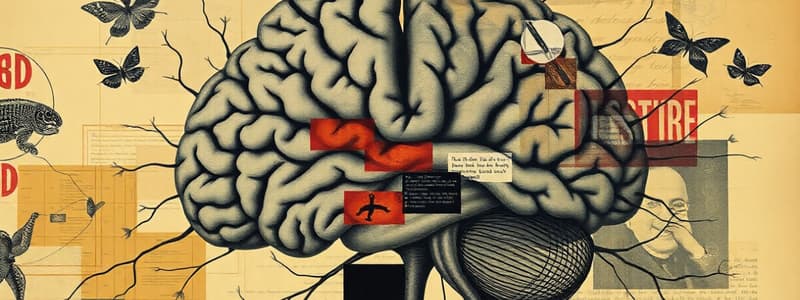Podcast
Questions and Answers
What components are included in the Central Nervous System (CNS)?
What components are included in the Central Nervous System (CNS)?
- Brain and spinal cord only (correct)
- Cranial nerves and spinal nerves
- Brain, spinal cord, and peripheral nerves
- Peripheral nerves and ganglia
What is the primary role of sensory (afferent) pathways in the nervous system?
What is the primary role of sensory (afferent) pathways in the nervous system?
- To transmit information from the CNS to skeletal muscles
- To facilitate chemical communication in the CNS
- To process and evaluate information
- To carry information to the CNS from the external and internal environments (correct)
Which of the following statements correctly describes myelination differences between the CNS and the PNS?
Which of the following statements correctly describes myelination differences between the CNS and the PNS?
- Astrocytes provide myelination in both CNS and PNS.
- Schwann cells myelinate axons in the PNS, while oligodendrocytes do so in the CNS. (correct)
- In the PNS, myelination is performed mainly by oligodendrocytes.
- Myelination does not significantly affect neural conduction speed.
What role does cerebrospinal fluid (CSF) play in the central nervous system?
What role does cerebrospinal fluid (CSF) play in the central nervous system?
Which of the following best describes the function of motor (efferent) pathways?
Which of the following best describes the function of motor (efferent) pathways?
Which of the following correctly identifies the components of the central nervous system (CNS)?
Which of the following correctly identifies the components of the central nervous system (CNS)?
What are the three main components of a neuron?
What are the three main components of a neuron?
How do sensory neurons differ from motor neurons?
How do sensory neurons differ from motor neurons?
Which division of the nervous system is responsible for voluntary muscle control?
Which division of the nervous system is responsible for voluntary muscle control?
Which type of neural tissue primarily composes the outer layer of the brain?
Which type of neural tissue primarily composes the outer layer of the brain?
What is the primary function of neurotransmitters in the central nervous system?
What is the primary function of neurotransmitters in the central nervous system?
Which structure connects different parts of the brain through nerve fibers?
Which structure connects different parts of the brain through nerve fibers?
What is the role of the meninges in the nervous system?
What is the role of the meninges in the nervous system?
What does the somatic division of the nervous system primarily control?
What does the somatic division of the nervous system primarily control?
Which component of a neuron is primarily responsible for receiving stimuli?
Which component of a neuron is primarily responsible for receiving stimuli?
What kind of signaling do neurons use for communication?
What kind of signaling do neurons use for communication?
Which part of the neuron is primarily composed of gray matter?
Which part of the neuron is primarily composed of gray matter?
What characterizes the autonomic nervous system's response?
What characterizes the autonomic nervous system's response?
Which division of the autonomic nervous system is responsible for the 'fight or flight' response?
Which division of the autonomic nervous system is responsible for the 'fight or flight' response?
What is the role of glial cells in the nervous system?
What is the role of glial cells in the nervous system?
What is indicated by the term 'amitotic' in the context of neurons?
What is indicated by the term 'amitotic' in the context of neurons?
Flashcards are hidden until you start studying
Study Notes
Central Nervous System (CNS) Components
- The CNS consists of the brain and spinal cord.
Sensory (Afferent) Pathways
- Sensory pathways transmit information from sensory receptors to the CNS.
Myelination Differences
- CNS myelination is formed by oligodendrocytes, while PNS myelination is formed by Schwann cells.
Cerebrospinal Fluid (CSF) Role
- CSF cushions the brain and spinal cord, provides nutrients, and removes waste products.
Motor (Efferent) Pathways
- Motor pathways carry signals from the CNS to muscles and glands.
Central Nervous System (CNS) Components
- The CNS is composed of the brain and spinal cord.
Neuron Components
- Neurons consist of a cell body (soma), dendrites, and an axon.
Sensory vs. Motor Neurons
- Sensory neurons transmit signals from sensory receptors to the CNS, while motor neurons transmit signals from the CNS to effectors.
Voluntary Muscle Control
- The somatic nervous system is responsible for voluntary muscle control.
Outer Layer of the Brain
- The outer layer of the brain is primarily composed of gray matter.
Neurotransmitter Function
- Neurotransmitters facilitate communication between neurons.
Brain Connections
- The corpus callosum connects different parts of the brain through nerve fibers.
Meninges Role
- The meninges protect the brain and spinal cord.
Somatic Nervous System Control
- The somatic nervous system controls skeletal muscle activity.
Neuron Stimulus Reception
- Dendrites are primarily responsible for receiving stimuli.
Neuron Communication Signaling
- Neurons use electrochemical signaling for communication.
Gray Matter Location
- Gray matter is primarily located in the cell bodies of neurons.
Autonomic Nervous System Response
- The autonomic nervous system controls involuntary bodily functions.
'Fight or Flight' Response
- The sympathetic division of the autonomic nervous system is responsible for the 'fight or flight' response.
Glial Cell Role
- Glial cells support and protect neurons.
Neurons and Amitosis
- The term 'amitotic' indicates that neurons generally do not undergo cell division.
Studying That Suits You
Use AI to generate personalized quizzes and flashcards to suit your learning preferences.



